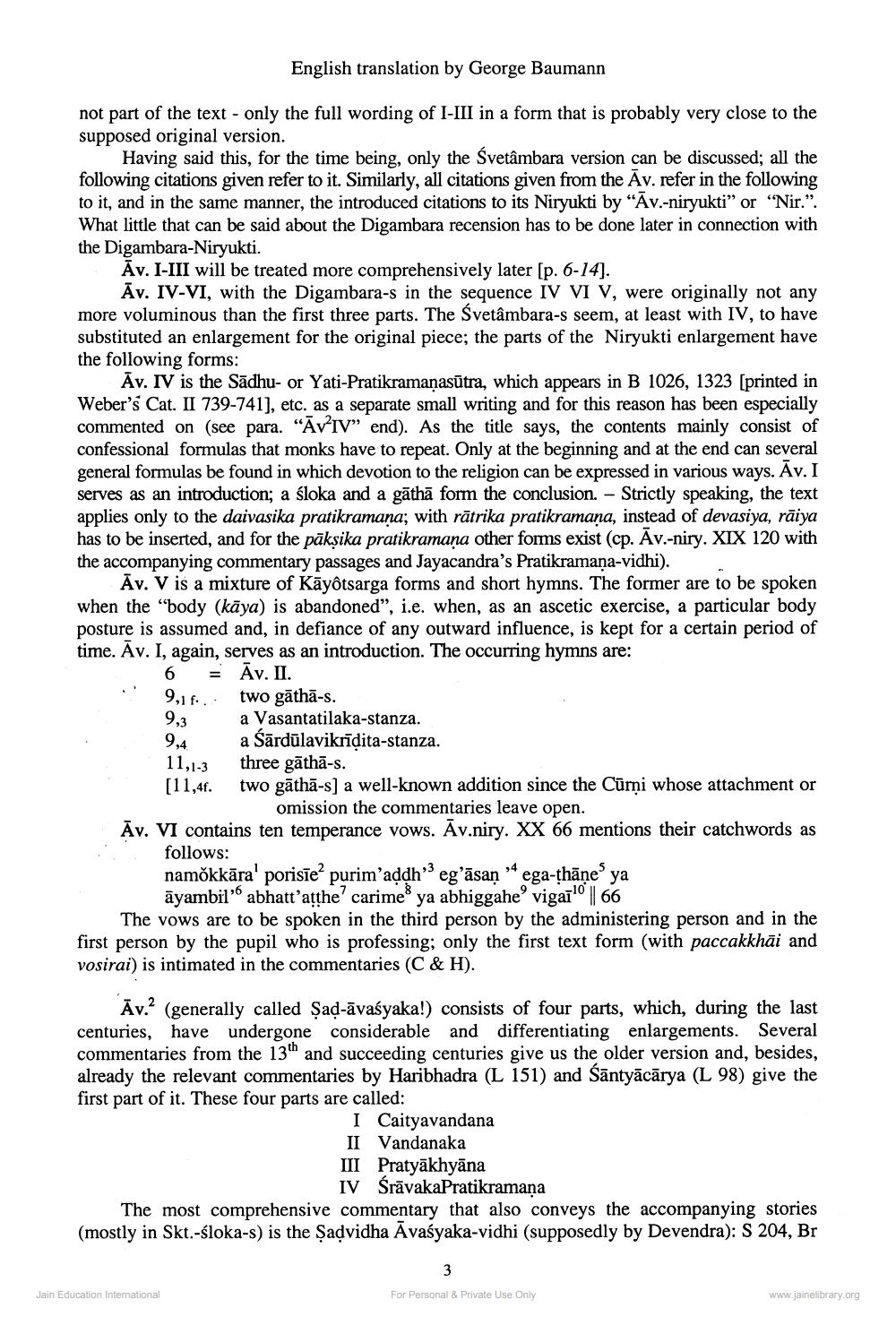________________
English translation by George Baumann
not part of the text - only the full wording of I-III in a form that is probably very close to the supposed original version.
Having said this, for the time being, only the Svetâmbara version can be discussed; all the following citations given refer to it. Similarly, all citations given from the Āv. refer in the following to it, and in the same manner, the introduced citations to its Niryukti by "Āv.-niryukti" or "Nir.". What little that can be said about the Digambara recension has to be done later in connection with the Digambara-Niryukti.
Āv. I-III will be treated more comprehensively later [p. 6-14].
Av. IV-VI, with the Digambara-s in the sequence IV VI V, were originally not any more voluminous than the first three parts. The Svetâmbara-s seem, at least with IV, to have substituted an enlargement for the original piece; the parts of the Niryukti enlargement have the following forms:
Āv. IV is the Sādhu- or Yati-Pratikramanasūtra, which appears in B 1026, 1323 (printed in Weber's Cat. II 739-741], etc. as a separate small writing and for this reason has been especially commented on (see para. "AVIV" end). As the title says, the contents mainly consist of confessional formulas that monks have to repeat. Only at the beginning and at the end can several general formulas be found in which devotion to the religion can be expressed in various ways. Av. I serves as an introduction; a sloka and a gāthā form the conclusion. - Strictly speaking, the text applies only to the daivasika pratikramana; with rātrika pratikramana, instead of devasiya, rāiya has to be inserted, and for the pāksika pratikramana other forms exist (cp. Āv.-niry. XIX 120 with the accompanying commentary passages and Jayacandra's Pratikramaņa-vidhi).
Āv. V is a mixture of Kāyôtsarga forms and short hymns. The former are to be spoken when the "body (kāya) is abandoned", i.e. when, as an ascetic exercise, a particular body posture is assumed and, in defiance of any outward influence, is kept for a certain period of time. Av. I, again, serves as an introduction. The occurring hymns are:
6 = Āv. II. 9,1 f... two gāthā-s. 9,3 a Vasantatilaka-stanza. 9,4 a Sārdūlavikrīdita-stanza. 11,1-3 three gāthā-s. [11,4f. two gāthā-s) a well-known addition since the Cūrņi whose attachment or
omission the commentaries leave open. Āv. VI contains ten temperance vows. Āv.niry. XX 66 mentions their catchwords as
follows: namökkāra' porisīe? purim'addh” eg’āsaņ” ega-thāņe' ya
āyambil" abhatt'atthe' carime ya abhiggahe vigai" || 66 The vows are to be spoken in the third person by the administering person and in the first person by the pupil who is professing; only the first text form (with paccakkhāi and vosirai) is intimated in the commentaries (C & H).
0
Āv.? (generally called Şad-āvaśyaka!) consists of four parts, which, during the last centuries, have undergone considerable and differentiating enlargements. Several commentaries from the 13th and succeeding centuries give us the older version and, besides, already the relevant commentaries by Haribhadra (L 151) and sāntyācārya (L 98) give the first part of it. These four parts are called:
I Caityavandana II Vandanaka III Pratyākhyāna
IV ŚrāvakaPratikramaņa The most comprehensive commentary that also conveys the accompanying stories (mostly in Skt.-śloka-s) is the Şadvidha Āvaśyaka-vidhi (supposedly by Devendra): S 204, Br
Jain Education International
For Personal & Private Use Only
www.jainelibrary.org




